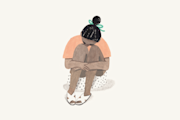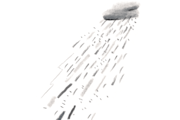We may think of depression as a state of low mood accompanied by reduced energy levels. In reality, there are many types of depression and depressive disorders with differing symptoms and severity.
Below we’ll explore the levels of depression—from mild to severe depression.
Then, we’ll discuss the seven types of depressive disorders—from bipolar disorder and major depressive disorder (MDD), to seasonal affective disorder (SAD) and premenstrual dysphoric disorder (PMDD).
Before we go into the various depression types, let’s illuminate the distinction between sadness and depression.
Sadness vs. depression
What’s the difference between common, routine sad thoughts and persistent or severe depression?
“Sadness is an emotion we experience in response to a trigger,” says licensed clinical psychologist Dr. Anton Shcherbakov, Psy.D, BCBA, a nationally recognized expert on mental health issues. “It’s usually time-limited and a normal, healthy part of the human experience.”
While sadness can persist for days or weeks, Dr. Shcherbakov says it typically comes and goes or waxes and wanes and fluctuates throughout any given day.
In contrast, he describes depression as “a much more persistent and ‘sticky’ state of mind.”
According to Dr. Shcherbakov, depression may occur “out of the blue.”
What’s more, depression is not typically a response to a single event.
“Depression is also characterized by significantly decreased motivation and difficulty finding pleasure in everyday life,” he says.
In other words, feelings of sadness alone do not constitute depression.
Depression is when our sadness:
Persists or doesn’t go away (aka “stickiness”)
Begins to impede our daily lives functioning. (This is determined based on an assessment of symptom severity.)

What are the levels of depression?
Depression levels are typically described as: mild, moderate or severe depression, with additional categories for melancholic or psychotic depression.
The extent to which symptoms prevent a person from functioning in their daily lives determines the level of depression affecting a particular individual.
This diagnosis is made when a physician or mental health professional takes into account the total number of symptoms, the severity of those symptoms, and their impact on the individual’s ability to function.
According to Dr. Shcherbakov, this determination should only be made by a mental health professional skilled in evaluating depression.
Monarch therapist Saba Harouni Lurie, LMFT, owner of Take Root Therapy, describes what each depression level can look like.
Mild depression
Feelings of hopelessness, irritability, and loss of interest in usual activities are signs of mild depression.
In mild depression, symptoms can persist for days, and they can be noticeable enough to interfere with day-to-day functioning.
Lurie explains that mild depression is the most difficult type of depression to diagnose as many people experiencing mild depression dismiss their early symptoms or think they can “pull themselves out of it.”
Moderate depression
The primary difference between mild and moderate depression is an increase in severity of symptoms.
Moderate depression symptoms may also include decreased productivity, lowered self-esteem, and feelings of worthlessness.
Severe depression
According to Lurie, symptoms of severe depression tend to be more noticeable to those around us and can include thoughts of dying and suicidal ideation.
Episodes of severe depression can last for months, rather than days, and they may require professional help in order to resolve.
Melancholic depression and psychotic depression
A specific type of severe depression, melancholic depression is characterized by a complete lack of pleasure in almost all activities, according to Dr. Shcherbakov.
Melancholic depression typically involves severe despair or so-called “empty mood.”
Hallucinations or delusions may also occur for some depressed patients.
When these symptoms are present, Dr. Shcherbakov explains, it is considered psychotic depression or “depression with psychotic features.”

Different types of depression
According to the American Psychological Association (APA) Diagnostic and Statistical Manual, fifth edition (DSM-5)—the handbook that provides guidelines for mental health professionals to diagnose psychiatric illnesses—a depression diagnosis requires five or more symptoms, and one of them must be either depressed mood or anhedonia.
In the DSM-5, the official diagnosis of depression is called major depressive disorder (MDD).
So, let’s start with that one.
Major depressive disorder (MDD)
According to Dr. Shcherbakov, major depressive disorder (MDD) is the most common diagnosis for individuals seeking treatment.
The National Institute of Mental Health (NIMH)’s 2020 National Survey on Drug Use and Health found an estimated 21 million adults had at least one major depressive episode in 2020.
Retired clinical psychologist Dr. John F. Tholen, Ph.D, author of Focused Positivity: The Path to Success and Peace of Mind, describes MDD symptoms as “feelings of hopelessness, suicidal ideation, social withdrawal, the inability to experience pleasure, loss of appetite and weight, and impaired ability to function.”
Symptoms of MDD
To be diagnosed with depression, 5 or more of the following symptoms must have been present during the same 2‐week period:
Depressed mood most of the day, nearly every day as indicated by either subjective report or observation made by others (for example, feeling sad, empty, hopeless)
Diminished interest or pleasure in all, or almost all, activities most of the day, nearly every day (aka anhedonia) as indicated by either subjective account or observation
Significant weight loss (when not dieting on purpose) or weight gain (for example, a change of more than 5% of body weight in a month), or decrease or increase in appetite nearly every day
Insomnia (having trouble sleeping) or hypersomnia (sleeping a lot more than usual) nearly every day. If you're wondering if you're depressed or just extra-tired, check out this guidance.
Psychomotor agitation or slowness nearly every day
Fatigue or loss of energy nearly every day
Diminished ability to focus, think, or concentrate, nearly every day
Feelings of worthlessness, low self-esteem, or excessive or inappropriate guilt nearly every day
Recurrent thoughts of death (not just fear of dying), recurrent suicidal ideation without a specific plan, or a suicide attempt or a specific plan for committing suicide
Persistent depressive disorder (PDD)
Persistent depressive disorder (PDD) is a less acute and often less severe form of depression that is more chronic or long-lasting, explains Dr. Shcherbakov.
In order to meet criteria for PDD, an individual must have 2 more depression symptoms, in addition to low mood, for at least 2 years.

Bipolar disorder
Dr. Shcherbakov describes bipolar disorder as a condition characterized by the presence of major depressive and manic (or hypomanic) episodes.
“Manic episodes involve highly elevated (or irritable) mood, decreased need for sleep, inflated self-esteem, increased productivity, and increased involvement in risky activities,” he says.
Seasonal affective disorder (SAD)
Seasonal affective disorder (SAD) is persistent low mood and depression that occurs during specific seasons of the year—typically in winter.
The most common pattern is onset of symptoms in fall, followed by remission in spring.
Although there can be episodes that occur in the warm summer months.
Psychotic depression
To be diagnosed with depression with psychotic features, in addition to symptoms of depression, a person must also be experiencing hallucinations or delusions.
This can include seeing or hearing things that are not there (hallucinations) or paranoia or other delusions, says Monarch therapist Alisa Kamis-Brinda, LCSW, LCADC, owner of Serenity Solutions, LLC.
Premenstrual dysphoric disorder (PMDD)
Kamis-Brinda explains that Premenstrual dysphoric disorder (PMDD) is diagnosed when someone experiences at least 5 of the following symptoms in the final week prior to their period:
Mood swings, sadness, or increased sensitivity to rejection
Irritability, anger, or increased conflicts with others
Depressed mood, hopelessness, or self-depreciation
Anxiety, tension, or feeling on edge
Decreased interest in usual activities
Difficulty concentrating
Lack of energy or fatigue
Change in appetite
Sleep disturbances
Feeling overwhelmed or out of control
Physical symptoms such as breast tenderness or swelling, joint or muscle pain, feeling bloated, or weight gain.
Symptoms typically start to improve within a few days of getting their period, and then go away after their menstrual period ends.

Postpartum depression (PPD)
Peripartum or postpartum depression (PPD) is diagnosed when someone experiences depressive symptoms during pregnancy or in the four weeks following delivery.
Situational depression aka adjustment disorder
“Situational depression is not an official diagnosis,” says Dr. Shcherbakov. “The official diagnosis would be adjustment disorder, which is a prolonged disruption in mood following a specific stressful event.”
How and when to find help for depression
“Feeling sad, or down, in response to a specific stressor is something that we all experience from time to time,” says Monarch psychologist Dr. Shauna Pollard, Ph.D. “However, if you find you are unable to shake these feelings for weeks or even months, you should reach out to a licensed professional for help.”
If you suspect you might be depressed, it’s important to reach out to a doctor or mental health professional, such as a therapist.
The Monarch Directory by SimplePractice can connect you with licensed therapists who specialize in treating depression.
You can quickly and easily view their availability and book a therapy session. Many offer free 15-minute initial consultations and in-person or teletherapy video sessions.
If you have health insurance coverage, you can also browse therapists who accept your insurance.
Remember, if you or a loved one is suffering from mental health issues, you are not alone.
Take our online depression assessment
If you’re concerned you might be depressed, take our online depression assessment to receive immediate feedback about whether you may be experiencing a depressive disorder.
It's fast, free, confidential, and clinically validated.
READ NEXT: Am I Depressed or Just Tired?
Need to find a therapist? The Monarch Directory by SimplePractice can help you find therapists near you who specialize in treating depression.





